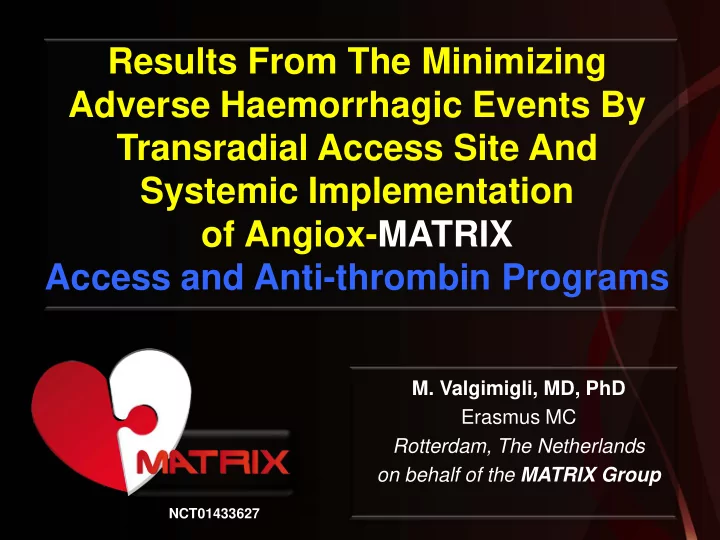

Results From The Minimizing Adverse Haemorrhagic Events By Transradial Access Site And Systemic Implementation of Angiox-MATRIX Access and Anti-thrombin Programs M. Valgimigli, MD, PhD Erasmus MC Rotterdam, The Netherlands on behalf of the MATRIX Group NCT01433627
Background • Previous studies have come to differing conclusions with regards to the role of radial access and bivalirudin in reducing adverse outcomes in patients with ACS • It remains unclear whether avoiding access site bleeding and vascular complications through routine transradial intervention or routine use of bivalirudin improves outcomes in unselected patients with ACS undergoing invasive management
MATRI X Program NCT01433627 NSTEACS or STEMI with invasive management Aspirin+ P2Y12 blocker 1:1 Trans-Radial Trans-Femoral Access Access 1:1 Bivalirudin Unfractionated Heparin with planned or Bailout GPI bailout GPI
MATRI X Acce ccess ss 8,404 patients with ACS undergoing coronary angiography ± PCI from 11 th Oct 2011 to 7 th Nov 2014 Operator Eligibility Criteria: I nterventional cardiologist expertise in TRI and TFI including at least 75 transradial coronary int ns and at least 50% of interventions nt erve vent nt ions performed via radial route in the year preceding site initiation 8,404 Am Heart J. 2014 Dec;168(6):838-45.e6. 8,404 8404 8073 7844 Cumulative enrollment by month 7638 7444 7235 6982 6742 6458 6184 Complete follow-up to 30 days available in 4183 5896 5655 5322 (99.7% ) of radial and 4191 (99·6% ) of femoral 5000 4726 4452 cohorts 4144 3875 3560 3256 2926 2584 2248 1972 1684 1400 1190 39 93 132 200 276 380 490 685 857 1002
MATRIX Recruiting timelines: Anti-thrombin program First Recruited patient: 11 th Oct 2011 Last Recruited patient: 7 th Nov 2014 7,213 7213 6896 Cumulative enrollment by month 6692 6521 6360 6176 5946 5735 Complete follow-up information at 30 days 5480 5233 4993 4787 available in all but 13 patients per group 4497 4228 4004 3762 3504 3276 3009 2738 2476 2176 1892 1670 1023 1200 1436 29 71 108 167 235 324 421 591 733 856
Cross Over and Procedural Success Rates 94.1% of radial and 97.4% of femoral cohorts received P<0.001 P=0.77 respective treatment as allocated I n 5.8% of radial and 2.3% of TF cohort the allocated access was attempted but failed. I n 3 (0.1% ) in the radial and 13 (0.3% ) patients in the femoral * groups the allocated access was not attempted *: TIMI <3 and/or % final stenosis >30%
Primary EP: MACE 10.3% 8.8% 15% significant reduction at nominal 5% alpha which is however NOT significant at the pre-specificed alpha of 2.5% Femoral Radial
Primary EP: NACE 11.7% 9.8% Rate Ratio 0.83; 95% CI , 0.73 to 0.96; p= 0.0092 Femoral NNTB: 53 Radial
Fatal and ST EPs : All-Cause, Cardiac, non-CV mortality, type of stent thrombosis Mortality Stent Thrombosis P=0.66 RR:0.72 % RR: 0.75 (0.53-0.99) (0.54-1.04) P=0.69 P=0.045 % P=0.08 NNTB: 167
Bleeding endpoints: BARC, TIMI, GUSTO, access vs non-access related P=0.0098 RR: 0.64 0.45-0.90 P=0.08 % RR: 0.72 P=0.20 0.50-1.04 RR: 0.78 P=0.0004 2.5% 0.53-1.14 RR: 0.37 P=0.68 0.21-0.66 P=0.013 RR: 0.67 1.4% 0.49-0.92 P=0.82 BARC 3 or 5 * ¶ *: Major or minor ¶: moderate or severe
Mortality: All-Cause, Cardiac, Vascular and non-CV mortality RR:0.70 RR: 0.68 (0.50-0.98) (0.48-0.97) P=0.037 % P=0.032 2.3% 1.7% UFH Bivalirudin
Bleeding endpoints: BARC, TIMI, GUSTO, access vs non-access related P=0.008 RR: 0.61 P=0.002 % 0.42-0.88 RR: 0.50 P=0.005 0.33-0.75 P=0.027 RR: 0.53 RR: 0.61 0.34-0.83 2.5% 0.39-0.95 P=0.07 RR: 0.59 0.33-1.04 1.4% P=0.0016 RR: 0.31 0.11-0.85 BARC 3 or 5 Major or minor Moderate or severe
Subgroup Analysis P-VALUES HAZARD RATIO (95% CI) HAZARD RATIO (95% CI) Superiority MACE Interaction 0.94 (0.77-1.15) 0.56 Femoral 0.98 Radial 0.62 0.95 (0.76-1.17) NACE Femoral 0.87 (0.72-1.05) 0.15 Radial 0.66 0.93 (0.75-1.14) 0.46 Death Femoral 0.66 (0.42-1.03) 0.07 Radial 0.64 0.77 (0.47-1.28) 0.31 Bleeding Femoral 0.50 (0.32-0.79) 0.0024 Radial 0.51 0.64 (0.37-1.10) 0.10 1 0.25 2 UFH Better Bivalirudin Better
Summary • Radial as compared to femoral access lowered the risk of NACE, driven by a significant reduction of mortality and bleeding with no difference for myocardial infarction or stent thrombosis. This effect was independent from the anticoagulant used during PCI but expertise in TRI was a treatment modifier. • Bivalirudin, when compared to UFH plus provisional GPI (used in 25% of patients) did not reduce the composite EP of MACE or NACE. however, the use of bivalirudin was associated to reduction of all- cause and CV death and bleeding including fatal ones. This effect was independent from the access site used during the procedure.
Recommend
More recommend